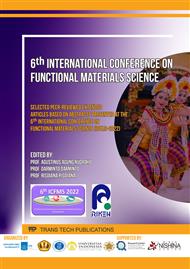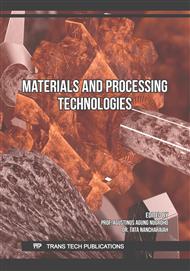[1]
Roesfitawati, "Aluminum Industry in Indonesia," Export News Indonesia, Jakarta, p.1–9, Jul. 2017.
Google Scholar
[2]
D. Dhaneswara, H. Rindharto, and M. Syauqi, "The Effect of Sample Placement in the Furnace during the Heat Treatment Process of 7075-T6 Aluminum Alloy on Microstructure, Hardness, and Electrical Conductivity," Journal of Materials Exploration and Findings, vol. 1, no. 1, Jul. 2022.
DOI: 10.7454/jmef.v1i1.1005
Google Scholar
[3]
D. Dhaneswara, J. F. Fatriansyah, N. Hanandhira, A. R. Basa, and M. Reza Firmansyah, "Effect of Sodium Nitrate-Sodium Fluoride Ratio as Degasser in Al-7Si-2Cu Casting Product," IOP Conf Ser Mater Sci Eng, vol. 547, no. 1, p.012037, Aug. 2019.
DOI: 10.1088/1757-899X/547/1/012037
Google Scholar
[4]
A. Zulfia, D. Ramdaniawati, and D. Dhaneswara, "The Role of Al2O3 Nanoparticles Addition on Characteristic of Al6061 Composite Produced by Stir Casting Process," International Journal of Materials Science and Engineering, vol. 6, no. 2, p.39–47, Jun. 2018.
DOI: 10.17706/ijmse.2018.6.2.39-47
Google Scholar
[5]
Y. Fugane, S. Kashiwakura, and K. Wagatsuma, "Rapid detection of inclusion particles in recycled aluminum materials by laser-induced plasma optical emission spectrometry with scanning laser beam," Surfaces and Interfaces, vol. 20, Sep. 2020.
DOI: 10.1016/j.surfin.2020.100602
Google Scholar
[6]
C. Voigt et al., "Filtration Efficiency of Functionalized Ceramic Foam Filters for Aluminum Melt Filtration," Metallurgical and Materials Transactions B: Process Metallurgy and Materials Processing Science, vol. 48, no. 1, p.497–505, Feb. 2017.
DOI: 10.1007/s11663-016-0869-5
Google Scholar
[7]
S. E. Fatmi, D. Dhaneswara, M. Anis, and A. Ashari, "Investigation of The Effect of Corundum Layer on The Heat Transfer of SiC Slab," Journal of Materials Exploration and Findings, vol. 1, no. 2, p.01–10, Dec. 2022.
DOI: 10.7454/jmef.v1i2.1012
Google Scholar
[8]
Widyantoro, D. Dhaneswara, J. Fajar Fatriansyah, M. Reza Firmansyah, and Y. Prasetyo, "Removal of Oxide Inclusions in Aluminium Scrap Casting Process with Sodium based Fluxes," MATEC Web of Conferences, vol. 269, p.07002, 2019, doi: 10.1051/matecconf/ 201926907002.
DOI: 10.1051/matecconf/201926907002
Google Scholar
[9]
X. CAO and J. CAMPBELL, "OXIDE INCLUSION DEFECTS IN Al-Si-Mg CAST ALLOYS," Canadian Metallurgical Quarterly, vol. 44, no. 4, p.435–448, Jan. 2005.
DOI: 10.1179/cmq.2005.44.4.435
Google Scholar
[10]
D. Fatimah, "Studi Banding Komposisi Kimia Kaolin Cipatujah-Jawa Barat Pasca Pemurnian dengan Asam; Terhadap Kaolin Bangka-Belitung," LIPI-14048, Oct. 2014.
Google Scholar
[11]
I. Muksin, C. Karangan, W. Setiawan, and L. N. Agung, "PROSPEKSI ZIRKON, PASIR KUARSA DAN KAOLIN DI KABUPATEN BANGKA TENGAH, PROVINSI KEPULAUAN BANGKA BELITUNG," 2015.
DOI: 10.13057/psnmbi/m010322
Google Scholar
[12]
W. Widodo, S. Subari, and B. D. Erlangga, "Characterization of Karangnunggal kaolin as raw materials for ceramic," Indonesian Mining Journal, vol. 19, no. 2, p.89–96, Nov. 2017.
DOI: 10.30556/imj.vol19.no2.2016.416
Google Scholar
[13]
M. Garcia-Valles, P. Alfonso, S. Martínez, and N. Roca, "Mineralogical and thermal characterization of kaolinitic clays from terra alta (Catalonia, Spain)," Minerals, vol. 10, no. 2, Feb. 2020.
DOI: 10.3390/min10020142
Google Scholar
[14]
L. Chen, Y. Luo, Y. Xia, B. Kang, and S. Yu, "Densification, microstructure and optical properties of YAG transparent ceramics prepared by dry-pressing and gelcasting," Opt Mater (Amst), vol. 121, Nov. 2021.
DOI: 10.1016/j.optmat.2021.111509
Google Scholar
[15]
W. M. Sigmund, N. S. Bell, and L. Bergström, "Novel Powder-Processing Methods for Advanced Ceramics," Journal of the American Ceramic Society, vol. 83, no. 7, p.1557–1574, 2000.
DOI: 10.1111/j.1151-2916.2000.tb01432.x
Google Scholar
[16]
E. Gregorová, Z. Živcová, and W. Pabst, "Porous Ceramics Made Using Potato Starch as a Pore-forming Agent," 2008.
Google Scholar
[17]
E. Kurovics et al., "Preparation of particle-reinforced mullite composite ceramic materials using kaolin and IG-017 bio-origin additives," Epitoanyag - Journal of Silicate Based and Composite Materials, vol. 71, no. 4, p.114–119, 2019.
DOI: 10.14382/epitoanyag-jsbcm.2019.20
Google Scholar
[18]
C. Y. Chen, G. S. Lan, and W. H. Tuan, "Preparation of mullite by the reaction sintering of kaolinite and alumina," 2000.
Google Scholar
[19]
P. J. Sánchez-Soto, D. Eliche-Quesada, S. Martínez-Martínez, L. Pérez-Villarejo, and E. Garzón, "Study of a Waste Kaolin as Raw Material for Mullite Ceramics and Mullite Refractories by Reaction Sintering," Materials, vol. 15, no. 2, Jan. 2022.
DOI: 10.3390/ma15020583
Google Scholar
[20]
F. Chargui, M. Hamidouche, H. Belhouchet, Y. Jorand, R. Doufnoune, and G. Fantozzi, "Mullite fabrication from natural kaolin and aluminium slag," Boletin de la Sociedad Espanola de Ceramica y Vidrio, vol. 57, no. 4, p.169–177, Jul. 2018.
DOI: 10.1016/j.bsecv.2018.01.001
Google Scholar
[21]
R. Mishra and R. S. Ningthoujam, "High-Temperature Ceramics," in Materials Under Extreme Conditions: Recent Trends and Future Prospects, Elsevier Inc., 2017, p.377–409.
DOI: 10.1016/B978-0-12-801300-7.00011-5
Google Scholar
[22]
S. Li, C. A. Wang, and J. Zhou, "Effect of starch addition on microstructure and properties of highly porous alumina ceramics," Ceram Int, vol. 39, no. 8, p.8833–8839, Dec. 2013.
DOI: 10.1016/j.ceramint.2013.04.072
Google Scholar
[23]
H. NISHIJIMA and Y. SUZUKI, "Microstructural control of porous Al2TiO5 by using various starches as pore-forming agents," Journal of the Ceramic Society of Japan, vol. 122, no. 1427, p.565–569, 2014.
DOI: 10.2109/jcersj2.122.565
Google Scholar
[24]
H. Elomari et al., "Influence of starch content on the properties of low cost microfiltration membranes," Journal of Asian Ceramic Societies, vol. 5, no. 3, p.313–319, Sep. 2017.
DOI: 10.1016/j.jascer.2017.06.004
Google Scholar



